Filotecnica Richtfernrohr 6,5xDies ist ein italienisches Richtfernrohr aus den 1930ern bis zum 2. Weltkrieg der Fa. Filotecnica in Mailand. Es gehört zu einem Theodoliten bzw. Richtkreis.Es hat die optischen Werte 6,5x18 und eine unvergütete Optik. Das Visier ist aus Messing und Aluminium. Es wiegt mit Montageschiene 387g. Das Porro-1-Prismensystem ist in einme 51x52x34mm großen Gehäuse (ohne Montageschiene) mit geriffelten Flächen untergebracht. Der Objektivtubus ist 26mm lang und hat einen Durchmesser von 24mm am Gehäuseansatz und 30mm am geriffelten Endring. Das Okularteil misst 48-57mm je nach Justierung des Dioptrienausgleichs (von - bis + 7, Striche ohne Beschriftung). Die Gesamtlänge beträgt somit ca. 13,5cm. Die Aluminiumaugenmuschel ist 36mm im Durchmesser. |
Filotecnica director sight 6.5xHere is an Italian director sight from the 1930s to WWII made by Filotecnica, Milano. It is part of a theodolite or aiming circle respectively.The uncoated optics have a specification of 6.5x18. The sight is made of brass and aluminium. With its mounting rail it weighs 387g. Its porro 1-prism system is built into a 51x52x34mm housing (measured without mounting rail), which has milled sides. The objective tube is 26mm in length and a diameter of 24mm at ist set-off and 30mm at its end ring. The eyepiece measures 48-57mm depending on the dioptre adjustment which is ranging from - to + 7 having a scale but no numbers. So, its overall length is ca. 13,5cm. The aluminium eye-cup has a diameter of 36cm. |
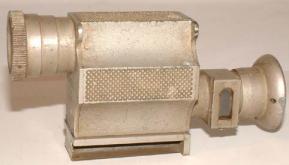
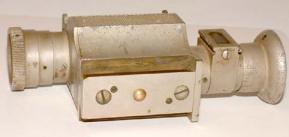
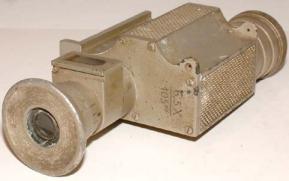
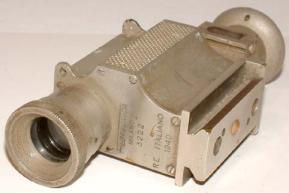
| Das Okular ist mit einer Fadenkreuzstrichplatte mit Skaleneinteilung versehen. Die horizontale Einteilung geht in ganzen Schritten von 1 - 9; die vertikale Einteilung bis 9 ist noch mit 4 weiteren Strichen zwischen den Ganzen markiert. Zur Anvisierung in der Nacht gibt es ein kleines Fenster zur Strichplattenbeleuchtung an der linken Okularstückseite. Beide Gehäusedeckel haben ein Loch zur Befestigung eines weiteren Teiles oder für einen Trageriemen, möglicherweise auch als einfaches Visier. Der Okular seitige Deckel ist mit "6,5X" darunter unter einem Strich mit "105°°" beschriftet, der Objektiv seitige Deckel mit "Filotecnica Milano" und "RE Italiano 1940", dazwischen die Seriennummer – beim abgebildeten Exemplar "3222", beim Exemplar in meinem Besitz "10456". |
The ocular has a cross-hairs reticle with a scale. Its horizontal divison ranges from 1 to 9 in single steps; the vertical divison from 1 - 9 has also 4 subdivisions each step. There is a small window at the left ocular side for lighting the reticle. Each housing cover has a hole for some additional equipment or for a strap, but probably only a sort of sight. The ocular cover is labeled "6,5X", then below a line "105°°"; the objective cover is marked "Filotecnica Milano" and "RE Italiano 1940", whilst inbetween those markings is the serial number: it is 3222 on the pictured model, and 10456 on the model I own. |
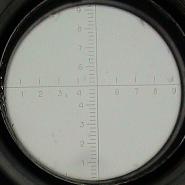
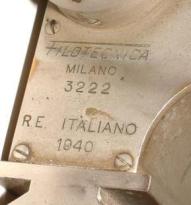
| Zum Zielen und Anvisieren gibt es eine Halterung, in deren obere Schiene das Richtfernrohr eingeschoben wird. Zur Einrichtung hat die Halterung mehrere Stellräder mit Skaleneinteilung zum Drehen und Kippen des Fernrohrs. Eine kleine Wasserwaage (nicht mehr intakt) sorgte für die ebene Ausrichtung des Geräts. Die Halterung selbst hat seitlich ein kleines Wappen sowie die Jahreszahl 1935 und die Teilenummer 353 eingraviert. Sie lässt sich auf ein Stativstutzen mit 22mm Durchmesser aufstecken. Einige Exemplare haben eine zusätliche um 45° geneigte Montageschiene und ein seitlich an die Montage aufschiebbares Hilfsnevillierfernrohr. |
There is a mount for aiming and sighting. The sight can be slipped into the top rail. To adjust the sight in all directions, there are several knobs and wheels with adjustment scales. A tiny bubble level (broken) was meant to level the device. The mount itself has a small coat-of-arms, the date 1935, and the part number 353 engraved at its side. The mount can be put onto a 22mm tripod rod. Some specimen come with an extra 45° tilted mounting rack and an auxiliary level telescope that can be slid on the side of the mounting. |
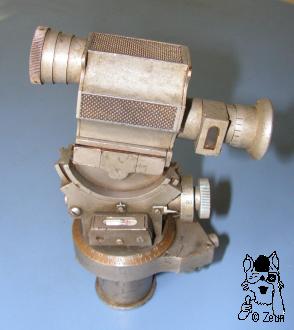
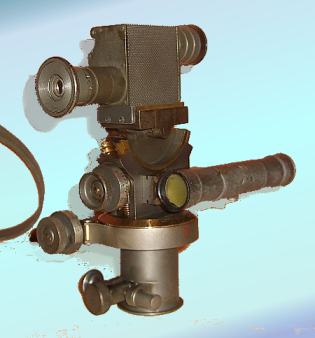

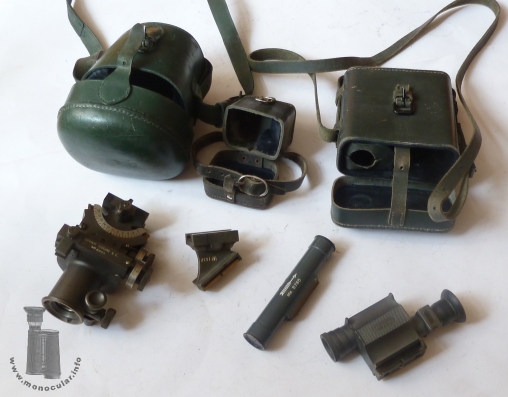
| Das identisches Gerät wurde für die italienische Armee auch von der Firma "Nistri Ottica Meccanica Italiana" aus Rom und "San Giorgio" aus Genua hergestellt (auch mit "Sestri Ponente" = Stadteil Genuas beschriftet) und Koristka (s. Bilder 8-9). Der Richtkreidaufsatz ist bei manchen Exemplaren mit "Cipriani Baccani & C." (aus Florenz) beschriftet. Eine Modellvariante von Filotecnica aus dem 1. Weltkrieg (datiert 1916) hat eine etwas andere Bauform mit einem kürzerem Prismengehäuse und längerem Objektivtubus sowie einer Hartgummiaugenmuschel (s. letztes Foto). |
The identical instrument was made by "Nistri Ottica Meccanica Italiana" of Rome and "San Giorgio" in Genoa (also inscribed "Sestri Ponente" = quarter of Genoa) and Koristka (see pics 8-9). The aiming circle mount is marked "Cipriani Baccani & C." (from Florence) on some models. Another model by Filotecnica dating from about WWI (1916) is made in a different design with a shorter prism housing, a longer eyeppiece and a ebonite eyecup (see last photo). |
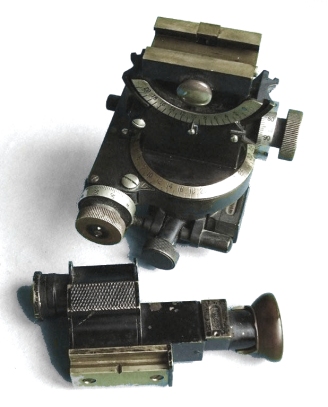
Fotos: Zeun; 1-4, 6 Ebay; 7, 9, 10, 12 Internet

